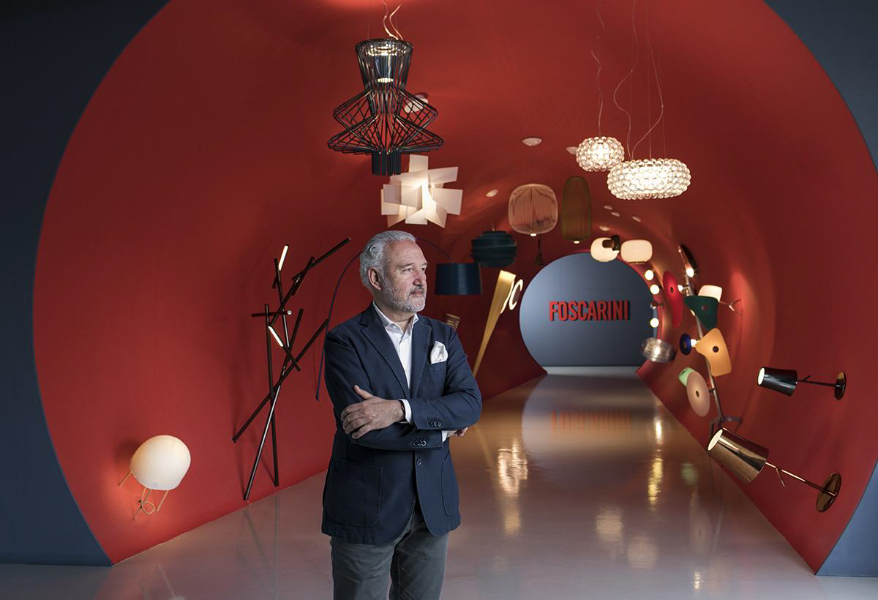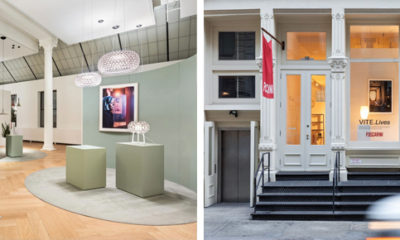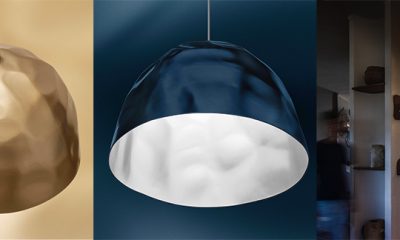(PRESS RELEASE) In 2023, Foscarini celebrates 40 years of creativity, research, innovation, and collaboration with its designers and lighting enthusiasts around the world. The company was founded in 1981 on the island of Murano, in Venice, the home of glass craftsmanship. Its initial objective was to develop custom lighting systems for the contract sector. 1983 marked the birth of the first catalog collection of designer lamps.
From the beginning, Foscarini has had a special feature that sets it apart from other Murano companies: it does not produce its objects in-house. Foscarini addresses the best-specialized suppliers for each of its projects, thus seeking production solutions adapted to each object. This modus operandi has proven over the years to be one of the keys to the development and success of Foscarini. Choose an idea, a design with a strong emotional impact, develop the best technical and productive solutions to express and transform the original idea into a concrete reality – and sometimes discover new paths in the lighting sector: This is the Foscarini “recipe.”
In 1988, Carlo Urbinati, who had joined Foscarini as a designer and designed the first lamps in the collection (with his partner at the time, Alessandro Vecchiato, who has since left the company), took up the challenge of acquiring Foscarini. Direct management led Urbinati to move from designing a collection to designing a company, investing his energies in defining new strategies and consolidating Foscarini’s identity as a design-driven company with a mindset open to innovation and experimentation.
1992 marked a turning point in the development of Foscarini, which, for the first time, freed itself from Murano glass. Ferruccio Laviani’s first lamp, Orbital, uses industrial glass instead of blown glass. It became a Foscarini icon, a sculptural lamp focused on the evocative and emotional nature of the product. The following year, in 1993, the Havana lamp by Jozeph Forakis used a material other than glass for the first time: polyethylene. This material corresponded to the lamp’s need for a light and mobile body. The decision to abandon blown glass as the material of choice also led to a geographical shift: Foscarini relocated to the mainland of Marcon, in Venice, to meet a logistical need inherent to the growth of the company.
In 2000, Foscarini produced the Mite lamp in collaboration with Marc Sadler after more than two years of research. To develop this project, a new material appeared: a mixture of fiberglass and carbon or Kevlar thread. Mite earned Foscarini and Marc Sadler the Compasso d’Oro ADI award.
In 2003, the Foscarini collection celebrated its 20th anniversary with the opening of a new headquarters, still in Marcon. From then on, the business grew rapidly. It continues to create models that often become true design icons. This is notably the case of Lumiere by Rodolfo Dordoni, Twiggy by Marc Sadler, Gregg by L + R Palomba, Caboche by Patricia Urquiola and Eliana Gerotto, Aplomb by Lucidi e Pevere, Spokes by Garcia Cumini, Satellight by Eugeni Quitllet, and Tobia by Ferruccio Laviani.
Advertisement
Thanks to his cultural vocation and passion for innovation, Foscarini took up a new challenge in 2010 by creating the editorial project INVENTARIO, a book that takes a free and enlightened look at design, music, entertainment scenes, architecture, and art. Led by Beppe Finessi, INVENTARIO does not talk about Foscarini but is the spokesperson for the company’s values of research and innovation, creativity, and project culture. INVENTARIO, now in its 16th issue, has also been awarded the prestigious Compasso d’Oro ADI award.
The desire to continually find new ways to tell the story of light and its impact on people’s daily lives led Foscarini to launch in 2020, VITE. This project, signed by the artist, photographer, and videographer Gianluca Vassallo, is a journey inside real houses between Copenhagen, New York, Naples, Shanghai, and Venice. Three continents, 13 cities, and 25 houses later, Foscarini opens the second chapter of the project, VITE 2. This broadens the research approach and explores new latitudes in search of another light and culture of life.
VITE joins other projects, such as MAESTRIE, which highlights the artisanal know-how behind creating some of the Foscarini icons.
In May 2022, Foscarini decided to strengthen its distinctive role in the lighting design sector globally by acquiring 90 percent of the shares of Ingo Maurer GmbH. Founded in 1966 by designer Ingo Maurer, Ingo Maurer GmbH is a brand known for pieces that combine the ordinary and the extraordinary, provoking and entertaining at the same time, thanks to a fascinating tension between technique and expressiveness. Foscarini will support the growth and development of the Ingo Maurer brand in the international market by maintaining its historical identity and independent development.
Foscarini strives to make people feel at home in their homes and collective spaces. The company has always openly challenged the limits of possibility, whether those of materials or technologies. His luminous objects transmit the warmth and emotions of passionate craftsmanship. As a factory-free company, one of its strengths is the absence of exclusive links with designers and the absence of production constraints. Its creativity is unlimited.
Today, the Foscarini collection celebrates its 40th anniversary. It has 63 families of lamps, made with 26 different materials, and developed alongside more than 30 designers with the support of a network of small manufacturing companies strictly Made in Italy. The Foscarini collection is distributed in over 88 countries through 2,800 multi-brand stores and two flagship stores: Foscarini Spazio Monforte in Milan and Foscarini Spazio Soho in New York.
Advertisement
Forty years after the company’s creation, Carlo Urbinati maintains the same enthusiasm as at the beginning, so much so that when asked: “What is your favorite model? ” he invariably answers: “The next one.”


 Headlines1 week ago
Headlines1 week ago
 Headlines2 weeks ago
Headlines2 weeks ago
 Headlines7 days ago
Headlines7 days ago
 Headlines1 week ago
Headlines1 week ago
 Designer Dozen2 weeks ago
Designer Dozen2 weeks ago
 Headlines2 weeks ago
Headlines2 weeks ago
 Headlines2 weeks ago
Headlines2 weeks ago


















